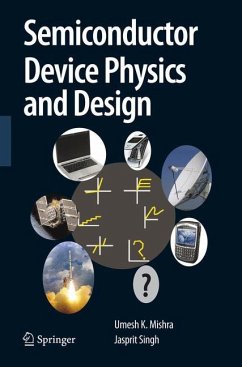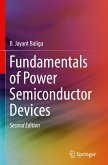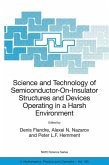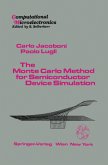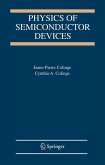Semiconductor Device Physics and Design provides a fresh and unique teaching tool. Over the last decade device performances are driven by new materials, scaling, heterostructures and new device concepts. Semiconductor devices have mostly relied on Si but increasingly GaAs, InGaAs and heterostructures made from Si/SiGe, GaAs/AlGaAs etc have become important. Over the last few years one of the most exciting new entries has been the nitride based heterostructures. New physics based on polar charges and polar interfaces has become important as a result of the nitrides. Nitride based devices are now used for high power applications and in lighting and display applications. For students to be able to participate in this exciting arena, a lot of physics, device concepts, heterostructure concepts and materials properties need to be understood. It is important to have a textbook that teaches students and practicing engineers about all these areas in a coherent manner.
16
emiconductor Device Physics and Design starts out with basic physics concepts including the physics behind polar heterostructures and strained heterostructures. Important devices ranging from p-n diodes to bipolar and field effect devices is then discussed. An important distinction users will find in this book is the discussion presented on device needs from the perspective of various technologies. For example, how much gain is needed in a transistor, how much power, what kind of device characteristics are needed. Not surprisingly the needs depend upon applications. The needs of an A/D or D/A converter will be different from that of an amplifier in a cell phone. Similarly the diodes used in a laptop will place different requirements on the device engineer than diodes used in a mixer circuit. By relating device design to device performance and then relating device needs to system use the student can see how device design works in real world.
This book is comprehensive without being overwhelming. The focus was to make this a useful text book so that the information contained is cohesive without including all aspects of device physics. The lesson plans demonstrated how this book could be used in a 1 semester or 2 quarter sequence.
16
emiconductor Device Physics and Design starts out with basic physics concepts including the physics behind polar heterostructures and strained heterostructures. Important devices ranging from p-n diodes to bipolar and field effect devices is then discussed. An important distinction users will find in this book is the discussion presented on device needs from the perspective of various technologies. For example, how much gain is needed in a transistor, how much power, what kind of device characteristics are needed. Not surprisingly the needs depend upon applications. The needs of an A/D or D/A converter will be different from that of an amplifier in a cell phone. Similarly the diodes used in a laptop will place different requirements on the device engineer than diodes used in a mixer circuit. By relating device design to device performance and then relating device needs to system use the student can see how device design works in real world.
This book is comprehensive without being overwhelming. The focus was to make this a useful text book so that the information contained is cohesive without including all aspects of device physics. The lesson plans demonstrated how this book could be used in a 1 semester or 2 quarter sequence.
From the reviews:
"This book is a course very well written and comprehensive dedicated to semiconductors. The authors have detailed fundamental concepts from basic physics until research and development topics. ... Important semiconductors properties are summarized in useful tables at the end of the book. To help students to be familiar with the theory, examples are detailed in the text and at the end of each chapter exercises are proposed." (Grégory Guisbiers, Physicalia, Vol. 30 (2), 2008)
"This is a classical textbook about the physics of semiconductor devices. It is intended for electrical engineers, but is also useful for young physicists. The book is very clear and covers all the main knowledge necessary for a graduate student in the area of semiconductors ... . It contains many helpful figures, examples and problem sets. This book is also a good guide for teachers. In addition, advanced researchers could use it because the needed information is easy to find and extremely well synthesized." (Mircea Dragoman, Optics and Photonics News, September, 2008)
"This book is a course very well written and comprehensive dedicated to semiconductors. The authors have detailed fundamental concepts from basic physics until research and development topics. ... Important semiconductors properties are summarized in useful tables at the end of the book. To help students to be familiar with the theory, examples are detailed in the text and at the end of each chapter exercises are proposed." (Grégory Guisbiers, Physicalia, Vol. 30 (2), 2008)
"This is a classical textbook about the physics of semiconductor devices. It is intended for electrical engineers, but is also useful for young physicists. The book is very clear and covers all the main knowledge necessary for a graduate student in the area of semiconductors ... . It contains many helpful figures, examples and problem sets. This book is also a good guide for teachers. In addition, advanced researchers could use it because the needed information is easy to find and extremely well synthesized." (Mircea Dragoman, Optics and Photonics News, September, 2008)

